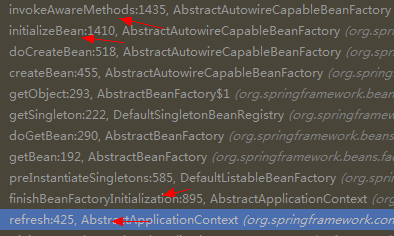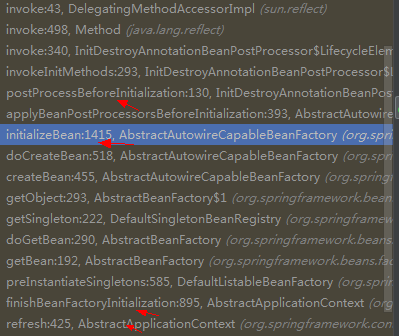spring源码-Aware-3.4
一、Aware接口,这个也是spring的拓展之一,为啥要单独拿出来讲呢,因为他相比于BeanFactoryPostProcessor,BeanPostProcessor的实用性更加高,并且在具体的业务中也可以灵活使用,主要是能够达到解耦的目的。
二、常用的Aware接口有:第一类:BeanNameAware/BeanClassLoaderAware/BeanFactoryAware。 第二类:EmbeddedValueResolverAware/ResourceLoaderAware/ApplicationEventPublisherAware/MessageSourceAware/ApplicationContextAware。这两类到底有啥区别类,其实没有太大的区别。但是在源码实现中还是存在很大的差别的(后面统一说道)。
三、源码实现:
1、第一类:BeanNameAware/BeanClassLoaderAware/BeanFactoryAware
1)实现方式:
import org.springframework.beans.factory.BeanNameAware; /**
* BeanNameAware/BeanClassLoaderAware/BeanFactoryAware类似
*/
public class TestBeanAware implements BeanNameAware{ private String beanName;
@Override
public void setBeanName(String beanName) {
System.out.println(beanName);
this.beanName = beanName;
} public String getBeanName() {
return beanName;
}
}
2)有啥区别
这里简单说明一下:相对于普通的bean,这里可以获取到beanName/classLoader/beanFactory。是对普通bean的一种增强,然后合理的应用才是关键
3)源码实现部分:
protected Object initializeBean(final String beanName, final Object bean, RootBeanDefinition mbd) {
if (System.getSecurityManager() != null) {
AccessController.doPrivileged(new PrivilegedAction<Object>() {
public Object run() {
AbstractAutowireCapableBeanFactory.this.invokeAwareMethods(beanName, bean);
return null;
}
}, this.getAccessControlContext());
} else {
this.invokeAwareMethods(beanName, bean);
}
Object wrappedBean = bean;
if (mbd == null || !mbd.isSynthetic()) {
wrappedBean = this.applyBeanPostProcessorsBeforeInitialization(bean, beanName);
}
try {
this.invokeInitMethods(beanName, wrappedBean, mbd);
} catch (Throwable var6) {
throw new BeanCreationException(mbd != null ? mbd.getResourceDescription() : null, beanName, "Invocation of init method failed", var6);
}
if (mbd == null || !mbd.isSynthetic()) {
wrappedBean = this.applyBeanPostProcessorsAfterInitialization(wrappedBean, beanName);
}
return wrappedBean;
}
private void invokeAwareMethods(String beanName, Object bean) {
if (bean instanceof BeanNameAware) {
((BeanNameAware)bean).setBeanName(beanName);
}
if (bean instanceof BeanClassLoaderAware) {
((BeanClassLoaderAware)bean).setBeanClassLoader(this.getBeanClassLoader());
}
if (bean instanceof BeanFactoryAware) {
((BeanFactoryAware)bean).setBeanFactory(this);
}
}
4)何时调用:spring源码-bean之加载-2 的3)点d.3 doCreateBean中的initializeBean()部分开始,所以这个其实是在getBean的时候才会调用。
5)测试的时候发现:在增强容器中refresh方法中finishBeanFactoryInitializationh会完成这部分的调用

2、第二类:EmbeddedValueResolverAware/ResourceLoaderAware/ApplicationEventPublisherAware/MessageSourceAware/ApplicationContextAware
1)实现方式:这里举两个例子EmbeddedValueResolverAware,ApplicationEventPublisherAware
a.EmbeddedValueResolverAware
import org.springframework.context.EmbeddedValueResolverAware;
import org.springframework.util.StringValueResolver; import javax.annotation.PostConstruct; public class TestEmbeddedValueResolverAware implements EmbeddedValueResolverAware { private StringValueResolver stringValueResolver; @Override
public void setEmbeddedValueResolver(StringValueResolver stringValueResolver) {
this.stringValueResolver = stringValueResolver;
} public String getProperties (String name) {
String elName = "${"+ name +"}";
return stringValueResolver.resolveStringValue(elName);
} @PostConstruct
public void test() {
System.out.println(getProperties("name"));
}
}
注意:这里是读取方式配置
<bean class="org.springframework.beans.factory.config.PropertyPlaceholderConfigurer">
<property name="locations">
<list>
<value>aware.properties</value>
</list>
</property>
</bean>
aware.properties
name=test
age=25
sex=boy
疑问:和这个有啥关系,看在StringValueResolver可以知道,这里的StringValueResolver指向的是PropertyPlaceholderConfigurer的内部类PlaceholderResolvingStringValueResolver,当然具体的实现有不同的方式
private class PlaceholderResolvingStringValueResolver implements StringValueResolver {
private final PropertyPlaceholderHelper helper;
private final PlaceholderResolver resolver;
public PlaceholderResolvingStringValueResolver(Properties props) {
this.helper = new PropertyPlaceholderHelper(PropertyPlaceholderConfigurer.this.placeholderPrefix, PropertyPlaceholderConfigurer.this.placeholderSuffix, PropertyPlaceholderConfigurer.this.valueSeparator, PropertyPlaceholderConfigurer.this.ignoreUnresolvablePlaceholders);
this.resolver = PropertyPlaceholderConfigurer.this.new PropertyPlaceholderConfigurerResolver(props, (PropertyPlaceholderConfigurer.PropertyPlaceholderConfigurerResolver)null);
}
public String resolveStringValue(String strVal) throws BeansException {
String value = this.helper.replacePlaceholders(strVal, this.resolver);
return value.equals(PropertyPlaceholderConfigurer.this.nullValue) ? null : value;
}
}
b.ApplicationEventPublisherAware
import org.springframework.context.ApplicationEvent;
import org.springframework.context.ApplicationEventPublisher;
import org.springframework.context.ApplicationEventPublisherAware; import javax.annotation.PostConstruct; public class TestApplicationEventPublisherAware implements ApplicationEventPublisherAware { private ApplicationEventPublisher publisher; @Override
public void setApplicationEventPublisher(ApplicationEventPublisher applicationEventPublisher) {
this.publisher = applicationEventPublisher;
} public ApplicationEventPublisher getPublisher() {
return publisher;
} public class TestEvent extends ApplicationEvent { private Object object; public TestEvent(Object source, Object object) {
super(source);
this.object = object;
} public Object getObject() {
return object;
}
} @PostConstruct
public void test() {
publisher.publishEvent(new TestEvent(this, "test"));
}
import org.springframework.context.ApplicationListener;
public class TestListener implements ApplicationListener<TestApplicationEventPublisherAware.TestEvent>{
@Override
public void onApplicationEvent(TestApplicationEventPublisherAware.TestEvent testEvent) {
System.out.println("TestEvent is Happen" + testEvent.getObject());
}
}
发布,监听的过程相信。在实际业务中很常用吧。这里监听过程后面会讲,这里不细说。
注意:这里用aware的接口方式实现发布,监听过程,会比直接调用的方式更加解耦。
2)重点来了,这玩意在哪里调用的呢。其实我们之前我们忽略了一个重点。
a.先看调用方式

看到postProcessBeforeInitialization应该感到高兴了,因为这不就是实现了BeanPostProcessor接口的前置调用过程吗。
有问题可以参考:spring源码-BeanPostProcessor-3.3
b.疑问:我们并没有手动去实现BeanPostProcessor的接口并且对aware接口做处理啊。
通过debug和查看堆栈信息可以知道方法调用在ApplicationContextAwareProcessor类里面
package org.springframework.context.support; import java.security.AccessControlContext;
import java.security.AccessController;
import java.security.PrivilegedAction;
import org.springframework.beans.BeansException;
import org.springframework.beans.factory.config.BeanPostProcessor;
import org.springframework.beans.factory.config.ConfigurableBeanFactory;
import org.springframework.context.ApplicationContextAware;
import org.springframework.context.ApplicationEventPublisherAware;
import org.springframework.context.ConfigurableApplicationContext;
import org.springframework.context.EmbeddedValueResolverAware;
import org.springframework.context.MessageSourceAware;
import org.springframework.context.ResourceLoaderAware;
import org.springframework.util.StringValueResolver; class ApplicationContextAwareProcessor implements BeanPostProcessor {
private final ConfigurableApplicationContext applicationContext; public ApplicationContextAwareProcessor(ConfigurableApplicationContext applicationContext) {
this.applicationContext = applicationContext;
} public Object postProcessBeforeInitialization(final Object bean, String beanName) throws BeansException {
AccessControlContext acc = null;
if (System.getSecurityManager() != null && (bean instanceof EmbeddedValueResolverAware || bean instanceof ResourceLoaderAware || bean instanceof ApplicationEventPublisherAware || bean instanceof MessageSourceAware || bean instanceof ApplicationContextAware)) {
acc = this.applicationContext.getBeanFactory().getAccessControlContext();
} if (acc != null) {
AccessController.doPrivileged(new PrivilegedAction<Object>() {
public Object run() {
ApplicationContextAwareProcessor.this.invokeAwareInterfaces(bean);
return null;
}
}, acc);
} else {
this.invokeAwareInterfaces(bean);
} return bean;
} private void invokeAwareInterfaces(Object bean) {
if (bean instanceof EmbeddedValueResolverAware) {
((EmbeddedValueResolverAware)bean).setEmbeddedValueResolver(new ApplicationContextAwareProcessor.EmbeddedValueResolver(this.applicationContext.getBeanFactory()));
} if (bean instanceof ResourceLoaderAware) {
((ResourceLoaderAware)bean).setResourceLoader(this.applicationContext);
} if (bean instanceof ApplicationEventPublisherAware) {
((ApplicationEventPublisherAware)bean).setApplicationEventPublisher(this.applicationContext);
} if (bean instanceof MessageSourceAware) {
((MessageSourceAware)bean).setMessageSource(this.applicationContext);
} if (bean instanceof ApplicationContextAware) {
((ApplicationContextAware)bean).setApplicationContext(this.applicationContext);
} } public Object postProcessAfterInitialization(Object bean, String beanName) {
return bean;
} private static class EmbeddedValueResolver implements StringValueResolver {
private final ConfigurableBeanFactory beanFactory; public EmbeddedValueResolver(ConfigurableBeanFactory beanFactory) {
this.beanFactory = beanFactory;
} public String resolveStringValue(String strVal) {
return this.beanFactory.resolveEmbeddedValue(strVal);
}
}
}
c、还有一个问题ApplicationContextAwareProcessor在哪里注册的呢?
通过源码方式查看到在refresh()的this.prepareBeanFactory(beanFactory);中提前准备了ApplicationContextAwareProcessor
protected void prepareBeanFactory(ConfigurableListableBeanFactory beanFactory) {
beanFactory.setBeanClassLoader(this.getClassLoader());
beanFactory.setBeanExpressionResolver(new StandardBeanExpressionResolver());
beanFactory.addPropertyEditorRegistrar(new ResourceEditorRegistrar(this));
beanFactory.addBeanPostProcessor(new ApplicationContextAwareProcessor(this));
beanFactory.ignoreDependencyInterface(ResourceLoaderAware.class);
beanFactory.ignoreDependencyInterface(ApplicationEventPublisherAware.class);
beanFactory.ignoreDependencyInterface(MessageSourceAware.class);
beanFactory.ignoreDependencyInterface(ApplicationContextAware.class);
beanFactory.registerResolvableDependency(BeanFactory.class, beanFactory);
beanFactory.registerResolvableDependency(ResourceLoader.class, this);
beanFactory.registerResolvableDependency(ApplicationEventPublisher.class, this);
beanFactory.registerResolvableDependency(ApplicationContext.class, this);
if (beanFactory.containsBean("loadTimeWeaver")) {
beanFactory.addBeanPostProcessor(new LoadTimeWeaverAwareProcessor(beanFactory));
beanFactory.setTempClassLoader(new ContextTypeMatchClassLoader(beanFactory.getBeanClassLoader()));
}
Object systemEnvironment;
if (!beanFactory.containsBean("systemProperties")) {
try {
systemEnvironment = System.getProperties();
} catch (AccessControlException var4) {
systemEnvironment = new ReadOnlySystemAttributesMap() {
protected String getSystemAttribute(String propertyName) {
try {
return System.getProperty(propertyName);
} catch (AccessControlException var3) {
if (AbstractApplicationContext.this.logger.isInfoEnabled()) {
AbstractApplicationContext.this.logger.info("Not allowed to obtain system property [" + propertyName + "]: " + var3.getMessage());
}
return null;
}
}
};
}
beanFactory.registerSingleton("systemProperties", systemEnvironment);
}
四:Aware接口部分就这么多吧,这里没有具体些实现和用法,但是相对于BeanFactoryPostProcessor,BeanPostProcessor。Aware在实际应用中会更加常用,这一部分是spring提供出来的拓展,也是必要重要的一个部分。
当然,我这里可能还存在一些纰漏,还请大佬指出来!
spring源码-Aware-3.4的更多相关文章
- spring源码:学习线索(li)
一.spring xml配置(不包括AOP,主要了解在初始化及实例化过程中spring配置文件中每项内容的具体实现过程,从根本上掌握spring) <bean>的名字 &,alia ...
- Spring源码情操陶冶-AbstractApplicationContext#initMessageSource
承接前文Spring源码情操陶冶-AbstractApplicationContext#registerBeanPostProcessors 约定web.xml配置的contextClass为默认值X ...
- 【Spring源码分析】非懒加载的单例Bean初始化过程(下篇)
doCreateBean方法 上文[Spring源码分析]非懒加载的单例Bean初始化过程(上篇),分析了单例的Bean初始化流程,并跟踪代码进入了主流程,看到了Bean是如何被实例化出来的.先贴一下 ...
- 【Spring源码分析】非懒加载的单例Bean初始化前后的一些操作
前言 之前两篇文章[Spring源码分析]非懒加载的单例Bean初始化过程(上篇)和[Spring源码分析]非懒加载的单例Bean初始化过程(下篇)比较详细地分析了非懒加载的单例Bean的初始化过程, ...
- 剑指Spring源码(二)
这是春节后的第一篇博客,我在构思这篇博客的时候,一度想放弃,想想要不要换个东西写,因为毕竟个人水平有限,Spring源码实在博大精深,不是我这个菜的抠脚的菜鸡可以驾驭的,怕误人子弟,还有就是源码分析类 ...
- 【spring源码分析】IOC容器初始化(二)
前言:在[spring源码分析]IOC容器初始化(一)文末中已经提出loadBeanDefinitions(DefaultListableBeanFactory)的重要性,本文将以此为切入点继续分析. ...
- spring源码:学习线索
一.spring xml配置(不包括AOP,主要了解在初始化及实例化过程中spring配置文件中每项内容的具体实现过程,从根本上掌握spring) <bean>的名字 &,alia ...
- 【spring源码分析】IOC容器初始化——查漏补缺(一)
前言:在[spring源码分析]IOC容器初始化(十一)中提到了初始化bean的三个步骤: 激活Aware方法. 后置处理器应用(before/after). 激活自定义的init方法. 这里我们就来 ...
- spring源码分析系列 (2) spring拓展接口BeanPostProcessor
Spring更多分析--spring源码分析系列 主要分析内容: 一.BeanPostProcessor简述与demo示例 二.BeanPostProcessor源码分析:注册时机和触发点 (源码基于 ...
- Spring源码分析:非懒加载的单例Bean初始化前后的一些操作
之前两篇文章Spring源码分析:非懒加载的单例Bean初始化过程(上)和Spring源码分析:非懒加载的单例Bean初始化过程(下)比较详细地分析了非懒加载的单例Bean的初始化过程,整个流程始于A ...
随机推荐
- Perl入门(七) Perl脚本的调试
版权声明:本文为博主原创文章.未经博主同意不得转载. https://blog.csdn.net/sunshoupo211/article/details/32711165 编程中错误不可避免.调试可 ...
- C/C++心得-结构体
先说句题外话,个人认为,基本上所有的高级语言被设计出来的最终目的是降低软件开发难度,提升软件开发人员素质和团队协作能力,降低软件维护的难度.在学习语言的时候,可以从这么方面来推测各种语言语法设计的原因 ...
- thinkphp5.0查询到的数据表中的路径是反斜杠导致无法正常显示图片怎么办?
添加到数据表中图片的路径有时会是反斜杠,这就导致了在url后面写路径的时候会识别不出来(不过src后面写路径就可以识别),所以就需要把路径中的反斜杠替换成正斜杠,代码如下: $datu = Db::q ...
- mac 系统安装selenium注意事项
mac最新系统:OS X EI Captian python: 本机自带的python2.7. (本来想升级3.5,觉得太复杂,放弃了) pip: https://pypi.python.org/py ...
- Mint-UI 的 DatetimePicker 日期时间插件的安装与使用
简介:Mint-UI是饿了么出品的基于vue的移动端组件库(element-ui是桌面端) 官网:http://mint-ui.github.io/docs/#/zh-cn2 项目环境:vue-cli ...
- jquery仿移动端支付宝键盘
最近做项目时碰到一个需求,就是在移动端支付页面点击支付按钮弹出一个支付键盘,类似于支付宝的那种.由于项目只是单纯的手机网站,而并非app,所以这个功能得由前端来实现.话不多说,先上图看看效果. 尼玛, ...
- 原生js实现简单轮播的淡入淡出效果
实现这种淡入淡出的轮播关键在于css的一种设置 首先它不能像传统的轮播显示隐藏 或者左右浮动 他应该让其固定定位使其重叠在一起 达到这种效果 然后设置c3动画属性 transition:1s; ...
- 在线预览word,excel文档
Google Doc 示例:https://jsfiddle.net/7xr419yb/ Microsoft Office 示例:https://jsfiddle.net/gcuzq343/
- day 17 成员
1.成员 在类中你能写的所有内容都是类的成员 2.变量 1. 实例变量:昨天写的就是实力变量,由对象去访问的变量 2. 类变量: 这个变量属于类.但是对象也可以访问 ...
- Python系列之入门篇——pytables及其客户端
pytables及其客户端查看 pytables # ubuntu sudo apt-get install python-tables pip install flask flask-httpaut ...
